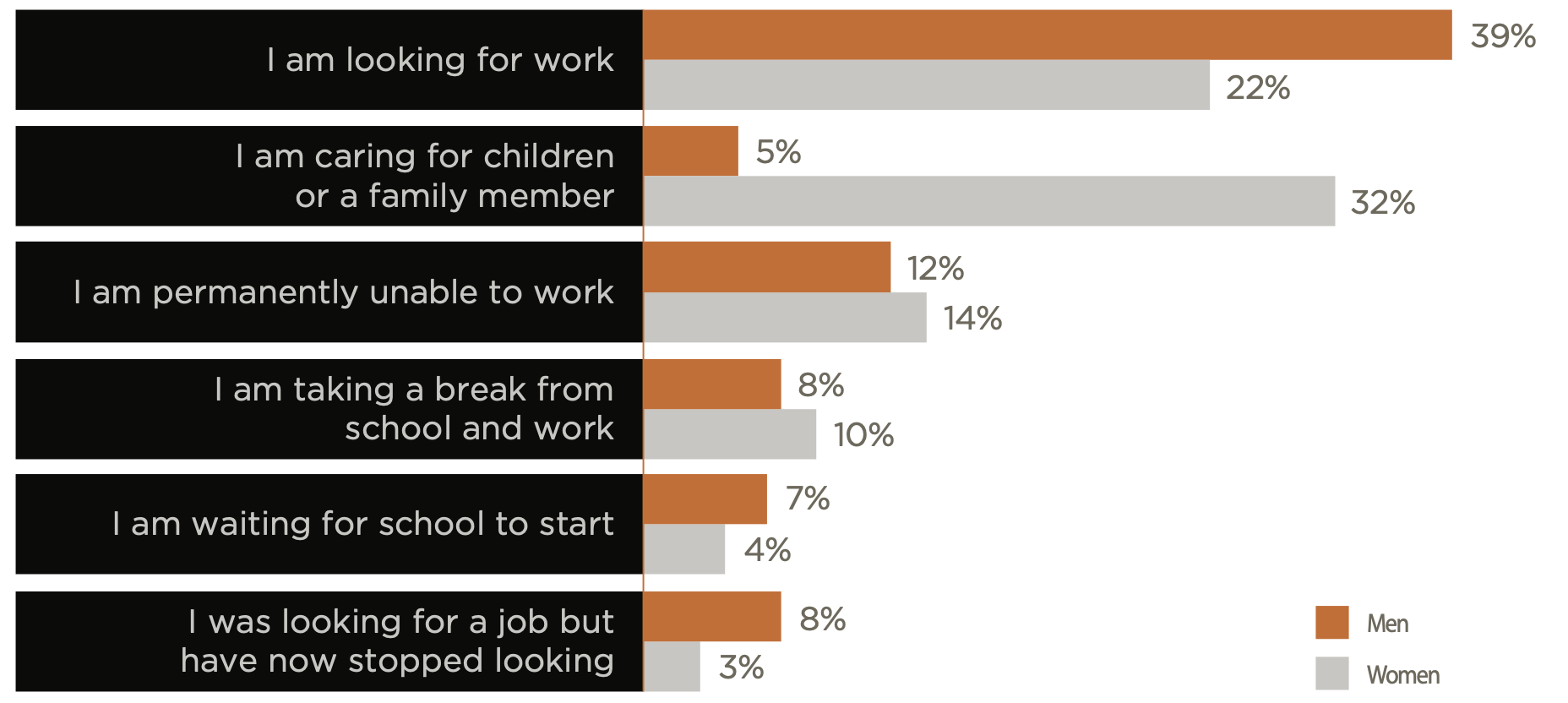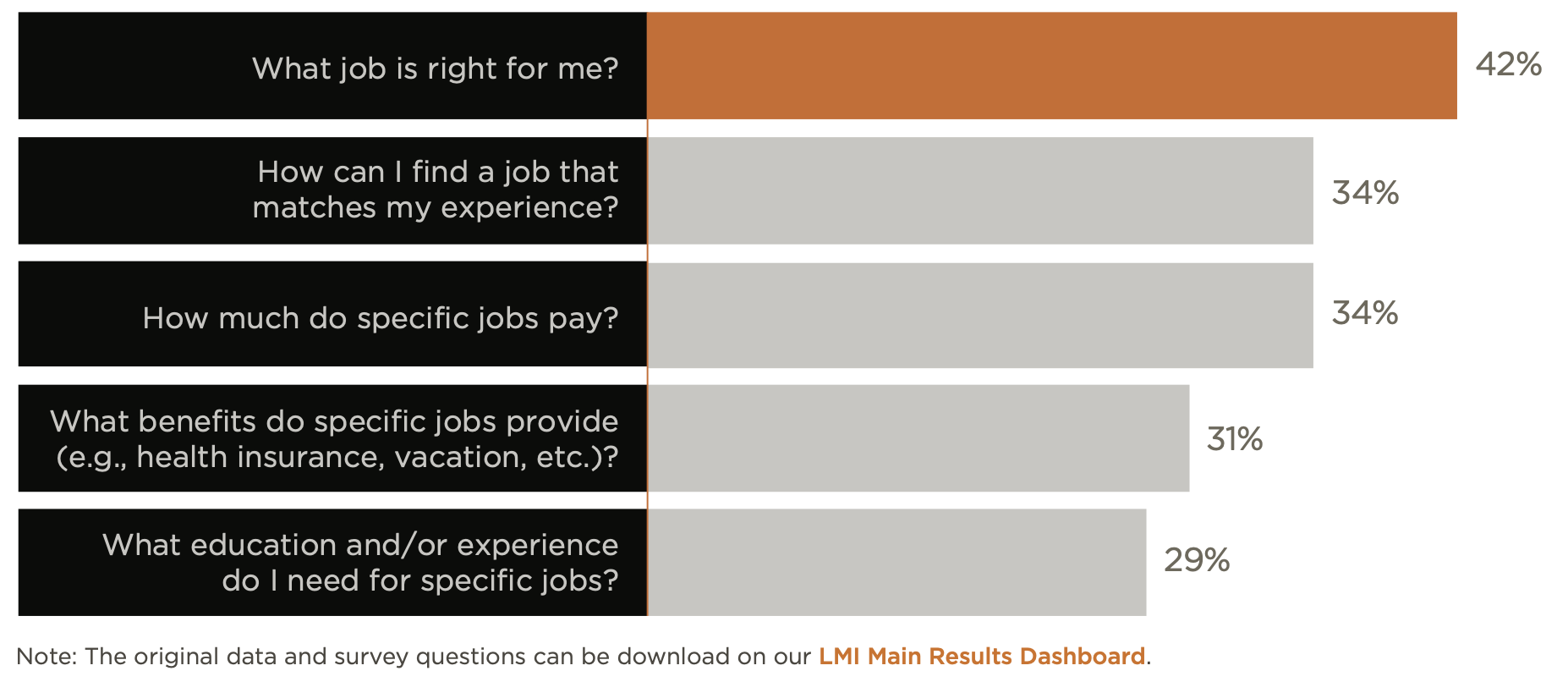Table of Contents
Key Findings
- Most Canadians aged 16 to 29 who are not in employment, education, or training (NEET) are typically in transition as they look for work or wait for school to start.
- One out of every five NEET youth wants to figure out what career to pursue within the next 12 months. To do so, they mainly look for labour market information related to job requirements, wages, and benefits.
- The main challenges NEET youth face in finding suitable work is lack of experience and an absence of job opportunities in their area.
- Family-related obligations are why close to one-third of women aged 16 to 29 (32%) are NEET compared with 5% of men.
Introduction
Canada has one of the world’s most educated workforces, and regularly ranks first among advanced countries in terms of the share of its population holding college or university degrees. At the same time, the Canadian labour market has been particularly robust in recent years. With more than 68% of those aged 16 to 29 holding a job,1 Canada’s youth employment rate is at its highest in a decade. Meanwhile, 21% of Canadians in that age group are enrolled in a post-secondary program - the highest enrollment rate since 2009.
Box 1: Defining NEET Youth
Organisation for Economic Co-operation and Development (OECD) member countries have published data on this segment of the population since the late 1990s. The OECD and Statistics Canada define NEET youth as." the share of young people [typically 15-29 years old] who are not in employment, education or training (NEET), as a percentage of the total number of young people in the corresponding age group, by gender." According to this definition, NEET youth can either be unemployed or not in the labour force.
These rosy statistics overshadow the fact that, according to Statistics Canada, about 11% of Canadians aged 15 to 29 are not in employment, education, or training (NEET) (Box 1). Youth in this category might be struggling to enter the labour market for the first time or to find stable employment. Some may have become discouraged and stopped looking for a job. To better understand the challenges they face, LMIC surveyed NEET youth about how they use labour market information (LMI) and how they evaluate LMI in Canada. (See Box 2 for details about how the survey was conducted.)
What Do NEET Youth Think About Labour Market Information?
As with other groups we’ve surveyed, a large share of NEET youth reported that finding and understanding labour market information is not easy. Less than half (46%) said LMI is easy to find, and only 58% said it is easy to understand. While a significant subset of NEET youth may have some trouble finding or understanding LMI, they are not alone, as other young Canadians we’ve surveyed, such as current students and recent graduates, also seem to have similar challenges. More encouragingly, 91% of the 300 NEET youths surveyed said it is important for them to use labour market information when making significant career- and education-related decisions. This was slightly more than the value for the overall Canadian population in the same age category (88%).
However, the results varied somewhat with age. For instance, whereas 41% of those aged 16 to 24 said LMI is easy to find and 51% said it is easy to understand, those figures were 57% and 69%, respectively, for respondents aged 25 to 29. Similarly, 96% of those in the latter age group said it is important to know about the labour market before making life choices, whereas only 88% of those aged 16 to 24 answered the same.
Box 2: Methodology
We conducted an online survey of how NEET youth use and evaluate labour market information. The sample was restricted to Canadian residents between the ages of 16 and 29 who were not currently employed or enrolled in a school (e.g., high school, CEGEP, college, university, etc.) or a longterm training program (e.g., an apprenticeship or other official certification program). Canadians aged 15 were excluded from the sample due to regulations pertaining to consent.
Due to the low incidence of NEET in the Canadian population in that age group (14%), the sample design did not apply quotas to ensure representativity by age, region, or gender. Although we sought to survey NEET youth from each province and territory, none of the respondents resided in Prince Edward Island, Yukon, Northwest Territories, or Nunavut.
A total of 300 respondents completed the online survey between May 9 and May 20, 2019. After collecting the data, we weighted them by age, gender, and region to replicate the Canadian population distribution as shown in the 2016 Canadian Census.
The precision of online polls is measured using credibility intervals. In this case, the results are accurate within +/- 6.5 percentage points. Credibility intervals are wider among subsets of the population.
Almost Half of NEET Youth Plan to Return to Education, Training, or the Labour Market
The results suggest that 47% of the NEET youth surveyed are planning to transition back to employment, education, or training.2 This implies that for young Canadians, not being employed, in school, or in a training program is usually an "in-between" situation. Indeed, when asked about their personal circumstances, about 30% of the NEET youth respondents said they are looking for a job, while another 6% said they are waiting for school to start.
About half of NEET youths surveyed (47%) hope to find meaningful work within the next 12 months.3 Of course, finding a job when you are out of work is always a challenge, and all the more so when you lack experience. Notably, more than a quarter (27%) of respondents stated that their lack of experience is a significant impediment to finding a job (Figure 1). Yet in many cases, the local labour market itself represents an important challenge: 21% of NEET youth said that there are no decent job opportunities in their area.
Figure 1. NEET youths face numerous challenges
Top 5 challenges NEET youths face when looking for a job, education, or training opportunities (% of respondents)

NEET youth frequently identified physical and mental health challenges as barriers to finding work or training opportunities. Among those surveyed, 22% said mental health issues represent a significant challenge, while 12% identified physical health issues as a hindrance. These findings speak to recent research showing that NEET youth in Canada are over-represented among those in need of social service assistance. Such research also shows that NEET youth are more likely to experience multiple overlapping issues, such as substance abuse and past trauma. When working to improve access to labour market information for NEET youth, it is important to bear in mind the high proportion of at-risk youths in this group and collaborate with social services providers.
In our survey results, women made up about half of the NEET population aged 16 to 29, but were overrepresented among older NEET youth, i.e., those aged 25 to 29 (where 58% were women). In this older NEET group, 46% of the women are not in the labour market because they are taking care of a child or family member. Overall, nearly a third (32%) of NEET women are out of the labour force because of family obligations. As shown in Figure 2, this is a stark contrast with NEET men, among whom less than 5% are NEET for this reason. The most common reason for men to fall into the NEET category is that they are looking for work. These results are consistent with recent research conducted by Statistics Canada.
Figure 2. Men and women tend to have different reasons for being NEET
Main activity while not in employment, education, or training by gender (% of respondents)

The circumstances of NEET youth also vary greatly by education level: 41% of university graduates are looking for a job, whereas 26% of those with a high school degree or less are looking for one. More concerning is that the latter group are also not seeking additional training or education. Only 9% said they are waiting for school to start.
Finding Their Way
Most NEET youths simply want a job that is right for them. Twenty percent of respondents stated that their primary goal over the next 12 months is to figure out what career to pursue. To do so, they will need to consider a number of factors. Survey respondents identified some of these when asked what questions they had, if any, about jobs and careers (Figure 3). The most frequent question they identified was, "What job is right for me?" (42%). They also wanted to know how their own experience could help them find an appropriate job (34%), how much they would earn (34%), what benefits were offered by employers (31%), and what education and experience were required for specific jobs (29%).
Such considerations were also the most commonly identified types of LMI that the surveyed NEET youth said they need (Figure 2). (They are also the LMI types most frequently identified by other user groups, as we reported in LMI Insight No. 8 and on our survey results dashboard.) Although the types of data sought by various user groups are quite similar, the challenge is to provide this information to NEET youths and other underrepresented groups in a digestible format that helps them make informed decisions about their education and careers.
Figure 3. Many NEET youth do not know what career they want to pursue
NEET youths’ top five questions about jobs and careers (% of respondents)

The Way Forward
The one in nine Canadian youth who are not in employment, education, or training (NEET) are an important underrepresented group in the Canadian labour market. We surveyed 300 NEET youth to find out more about what, if any, labour market information would most help them to make informed decisions.
The results from our survey are discussed above, but you can explore the findings further on our LMI Interactive Dashboard. This tool allows you to delve into the needs and challenges identified by NEET youth as well as their evaluation of labour market information. You can also compare these findings with the results from seven other surveys of other groups, including employed and unemployed Canadians, persons with disabilities, recent immigrants, recent graduates, students, and parents.
Our survey provides further evidence that many NEET youth are in transition - looking for work or waiting for school to start. However, one-third are women caring for a relative or a child. We also found that many NEET youth are simply looking for work that is right for them, based not only on job requirements but on their experiences and compensation expectations. This suggests that labour market information can play a role in helping NEET youth make informed decisions by prioritizing detailed (that is, local, granular) data that are properly contextualized to individuals’ specific needs and interests to help them transition into the labour market, education, or training. At LMIC, we are already working to provide the most localized and granular data possible. But to bring proper context to these data, we will seek to collaborate with employment service providers, youth networks, and, in some cases, social support workers, who are at the front lines of helping NEET youth make the best decisions for themselves.
Check out LMI Insights on LMIC’s public opinion research to learn more about these challenges:
- Is it Difficult to Find Information that Helps Career-Related Decisions?
- Easily Understood LMI is Essential for Making Informed Career Decisions
- LMI has Important Impact on the Career Paths of Canadians
- LMI Most Wanted by Canadians: Wages and Skills
- Canadians Face Persistent Challenges When Looking for Job-Related Information
- Educational and Career Choices for Students and Parents: The Role of Labour Market Information
- Canadian Employers: Uneven Access to Labour Market Information
Try out our survey dashboard to visualize the results in an interactive way.
Keep in touch with LMIC through LinkedIn and Twitter to hear more about the results of our public opinion survey
Acknowledgments
This issue of LMI Insights was prepared by David Goulet of LMIC. For more information about this issue of LMI Insights or other LMIC activities, please check out our Publications page or contact David Goulet or Tony Bonen, Director, Research, Data and Analytics.
Check out the survey dashboard and previous editions of LMI Insights discussing the needs, challenges, and difficulties of finding labour market information. Additional results will be made available as analyses are completed.
End Notes
- LMIC calculations are based on data in 2018 from the Labour Force Survey. See Box 1 for further details.
- Includes those who described their main activity as "I am looking for a job," "I have a job lined up that starts later," "I am waiting for school to start," or "I am taking a break from school and work."
- Meaningful employment represents those who answered that over the next 12 months, they hope to "find stable employment," "find a job I love," or "find a well-paying job."


